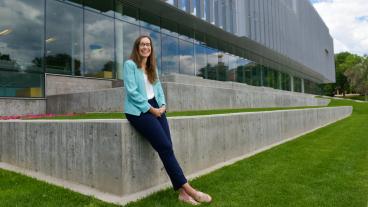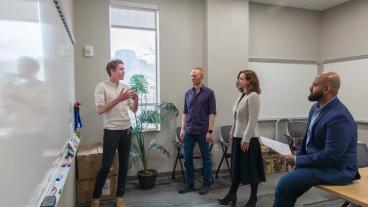 The new head of the Geophysics Department at Colorado School of Mines hopes to put a greater emphasis on the broader range of issues that geophysicists can contribute to in society.
The new head of the Geophysics Department at Colorado School of Mines hopes to put a greater emphasis on the broader range of issues that geophysicists can contribute to in society.
John Bradford, who assumed his new role in August, joins Mines from Boise State University, where he served on the faculty since 2001 and as director of the Center for Geophysical Investigation of the Shallow Subsurface from 2006 to 2009.
Bradford takes the reins from Roel Snieder, who served as interim department head for the past year before being appointed this fall as the W. M. Keck Distinguished Professor of Professional Development Education. Professor Emeritus Terry Young held the position for years prior to that, from 2000 to 2016.
“The department was already looking to make a transition and the opportunity to help shepherd us through and help guide that transition is pretty exciting for me,” Bradford said. “I had no interest in being a caretaker department head. I want to make some changes and set us up for the coming century.”
A Colorado native, Bradford is a leader in the world of exploration geophysics, having held multiple positions within the Society for Exploration Geophysicists, including president-elect, president and past-president from 2014 to 2017. He was awarded SEG life membership in 2012.
Bradford received his PhD in geophysics from Rice University and bachelor’s degrees in both physics and engineering physics from the University of Kansas. Before joining Boise State, he served as an academic research scientist at the University of Wyoming from 1999 to 2001 and also worked as a research scientist at the Houston Advanced Research Center from 1995 to 1999, focused on topics ranging from spectral decomposition for seismic exploration to utility detection with ground-penetrating radar (GPR).
His research at Mines will mostly focus on GPR and developing new tools and data analysis techniques to quantify subsurface properties, he said.
“That has applications in many areas—characterizing groundwater contaminants, fluid flow and distribution through glaciers, better understanding groundwater systems, understanding snowpack—which is particularly important in the Mountain West—understanding sea ice, oil exploration in the Arctic environment, permafrost,” Bradford said. “One of the reasons I like geophysics is the interdisciplinary aspect.”
Bradford is also teaching Introduction to Geophysics this semester in collaboration with Brandon Dugan, associate professor and Baker Hughes Chair in Petrophysics and Borehole Geophysics.
They plan to integrate into the curriculum early on an awareness of the broader social impact of the work geophysicists do as well as developing the skill set to be able to communicate that to the broader public, Bradford said.
“Geophysics is by its nature interdisciplinary. We have had a long history and reputation primarily for oil and gas exploration, not exclusively but to a large extent. We have the ability to make contributions to many other areas such as hydrology, natural hazards and understanding climate change,” he said.
From the technical side, the department has also been redesigning its curriculum to put more emphasis on high-performance computing and big-data analytics, Bradford said. Leading that effort has been Paul Sava, associate professor and C. H. Green Chair of Exploration Geophysics.
“This is where our profession is going in the future,” Bradford said. “No other geophysics departments have really gone through the systematic evaluation and revision of their programming from the research side and the education side to really address that. We’re in a really good place to be in a leadership spot."



